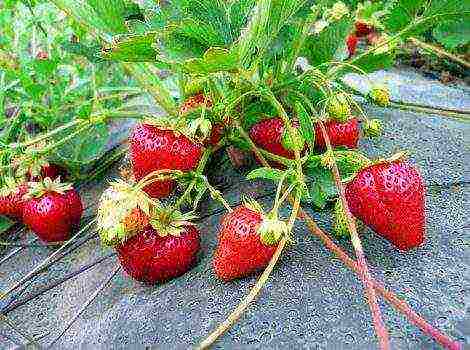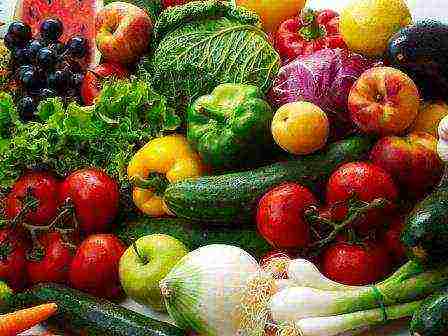Content
 Almost all houseplants in our country came from distant countries. And each of them requires an individual approach. One needs the sun, while the other can die from its influence and prefers shade. Some people need abundant moisture, but there are those that need to be forgotten. And in order for the plant to please the grower with its appearance, you need to know the rules required for care. Consider a catalog of popular indoor flowers.
Almost all houseplants in our country came from distant countries. And each of them requires an individual approach. One needs the sun, while the other can die from its influence and prefers shade. Some people need abundant moisture, but there are those that need to be forgotten. And in order for the plant to please the grower with its appearance, you need to know the rules required for care. Consider a catalog of popular indoor flowers.
Indoor plant classification
All pets plants can be divided into 4 groups, each of which has its own characteristics and characteristics. Groups:
- decorative and leafy. This group, if you follow all the rules for care, will be with flower growers for a long time. Their leaves are mostly green all year round. The only thing is that there are species that should be removed to cool rooms in winter.
- decorative blooming. Flowers of this group are referred to as centenarians. Their leaves do not die off after flowering, it is just that in some of their species they become not so attractive. Among the indoor plants of this species, some need to be provided with coolness in winter, and some should be taken out into the garden for the summer.
- decorative flowering pot plants. These types are mainly used for a variety of floral arrangements. After they have lost their appearance, they are simply disposed of. But, if tubers of some species are left, then it is possible to use them next year. That is, the plants of this group can be decorative and flowering for a short time.
- cacti. This is the most famous and popular species. Their stems are covered with spines and hairs. Sometimes they are found in cacti and leaves that are common to us. Many of the cacti can bloom. They are long-livers and quite unpretentious.
Catalog of indoor flowers
Consider the names related to ornamental-deciduous, which are valued for beautiful leaves, as well as decorative-flowering, capable of boasting beautiful flowering.
Dracaena
 It is a shrub that attracts with its exotic appearance. It has a rosette of leaves with straight stems that turn into a trunk over time. Depending on the species and age, it can reach three meters... The leaves of this home plant are juicy green and elongated. Dracaena, with proper care in room conditions, can last up to 15 years. Dracaena types:
It is a shrub that attracts with its exotic appearance. It has a rosette of leaves with straight stems that turn into a trunk over time. Depending on the species and age, it can reach three meters... The leaves of this home plant are juicy green and elongated. Dracaena, with proper care in room conditions, can last up to 15 years. Dracaena types:
- dracaena tree
- dracaena cinnabar
- Dracaena deremenskaya
- dragon tree
- fragrant dracaena
- Dracaena Godzef
Dracaena is an unpretentious shrub that will not cause huge trouble to the grower, if you follow the following care rules:
- Dracaena is a light-loving plant, but it is necessary to protect it from direct sunlight.
- hygrophilous, abundant watering is necessary. It must be carried out as soon as the top layer of the soil has dried approximately 2 cm.
- before watering, it is advisable to loosen the soil.
Houseplants
Cypress
Refers to coniferous crops. Not picky about care, it will take root in a new place easily. He is very light-loving and is not afraid of the sun's rays. In insufficient light, cypress can die.... It does not tolerate drafts and strong winds, but the room where it grows needs to be ventilated regularly.
The plant loves moisture, so it must be sprayed, and containers with water can also be placed next to the pot. Cypress need to water regularly, observing this every day to prevent the soil from drying out. In winter, you can water less often to prevent root rot.
Cypress in May - September needs fertilizing. It can be purchased from specialized stores.
Decorative flowering indoor plants are loved because of the exquisite flowers. They are also among themselves differ in appearance, in care requirements, in smell... Examples of decorative flowering: saintpaulias, acacia, anthurium and others.
Saintpaulias or Usambara violets
These indoor flowers are almost perfect, because they bloom almost all year round, mostly without taking up much space on the windowsill. Many colors of flowers, there are both gentle shades and bright flashy ones. In order for violets to bring joy with their flowering, they need to create the necessary conditions. Saintpaulia care rules:
-
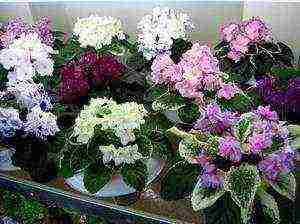 observe the temperature at which the Saintpaulias grow - this is 21-22 0С.
observe the temperature at which the Saintpaulias grow - this is 21-22 0С. - Saintpaulias do not tolerate drafts.
- grow well on windowsills from the west and east.
- watering is carried out with settled water and into a sump, or so that water does not fall on the leaves.
- watering as the soil dries out.
The lower leaves and faded flowers are cut off. If in the spring Saintpaulia gave a second outlet, then it must be cut off and put into water.
Anthurium
It has a shortened stem that can be aboveground or underground. Its leaves are green in color, reaching a length of 15 cm, and 7 cm wide, flowers come in a variety of colors. Anthurium care rules:
- protect from drafts.
-
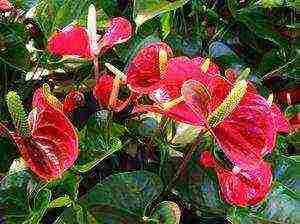 keep an indoor flower at a temperature of 18–20 ° C. In winter, it is imperative to isolate it from heating devices.
keep an indoor flower at a temperature of 18–20 ° C. In winter, it is imperative to isolate it from heating devices. - the window, as a rule, suits him an oriental one with a bright diffused light.
- with a lack of light, the plant must be illuminated with fluorescent lamps. If this is not done, then the leaves become shallow and the color of the flowers fades.
- regular watering as the upper soil slightly dries out, but it must be borne in mind that the soil does not dry out.
- the plant loves moisture, so it is advisable to spray it with water 2 times a day and ventilate the room where the anthurium stands.
Spathiphyllum
It is a stemless, short-rooted indoor plant. Views:
- cannoli spathiphyllum - differs from its other species in its wonderful flower aroma. Its leaves are juicy green. Blooms in spring and winter.
- spathiphyllum profusely blooming - can bloom throughout the year.
- Willis spathiphyllum - perfect for growing indoors.
- Spathiphyllum heliconielist - rather large, reaches a height of up to 1 m.
Spathiphyllum care rules:
-
 ambient light is suitable for indoor culture, because the direct rays of the sun cause burns on its leaves.
ambient light is suitable for indoor culture, because the direct rays of the sun cause burns on its leaves. - heat-loving plant. In summer, a temperature is needed - from 18 to 25 0С. In winter - not less than 14 ° C.
- does not tolerate drafts and cold air.
- watering should be carried out as the top layer of the soil dries up, in the spring-summer period, water abundantly, and in autumn and winter, cut only once a week.
Indoor plants, the photos and names of which you see below, belong to the decorative-flowering pot type. Difference from the previous type in the fact that such indoor flowers can only spend a short period of time in living quarters. If the plant begins to fade, then the days of this flower are already numbered.
Only some of their species can be saved. Therefore bmost plants are thrown away, some are keptby moving them cool, while others can be stored as bulbs until next planting.
The short life span of such cultures is the main drawback. These include flowers such as azalea, chrysanthemum, poinsettia, gloxinia.
Azalea
It is considered an evergreen, branched, flowering dwarf plant. Types of indoor azaleas:
- Indian azalea.The height of this evergreen shrub is up to 50 cm, its leaves are small, no more than 3.5 cm.
- Japanese azalea reaches a height of 50 cm, it has white shiny leaves, which are smaller than those of the previous species.
Basic rules for caring for room azalea:
-
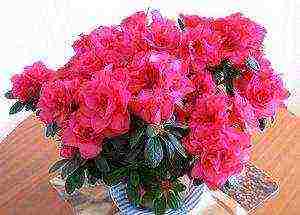 the window sill on the east side is perfect for her. The main thing to remember is that the light should be diffused.
the window sill on the east side is perfect for her. The main thing to remember is that the light should be diffused. - It is not thermophilic, therefore 15-18 degrees is sufficient, and during budding the temperature should be 5-6 0С lower.
- it needs sufficient moisture, for this it is necessary to spray the plant quite often with slightly cool water from a spray bottle. When the azalea blooms, you need to spray it carefully, since the delicate flowers can darken from the water, containers of water placed around will help you out of the situation.
- watering should be regular, abundant during flowering.
- do not overflow to avoid rotting of the rhizome.
Cacti are a separate type of indoor crops that delight the grower with their unpretentiousness.
Mammillaria
A fairly large cactus with a dark green stem in the shape of a ball or cylinder. The main the difference from all other cacti is the presence of papillae from which needles appear... The roots are, as a rule, on the surface, only the root system in the center goes deeper. Types of Mammillaria cactus:
- Mamilaria shide is a miniature form, shaped like a ball with a diameter of 4 cm.
- Large-nosed mammillaria - this species is distinguished by its large size, up to 30 cm high.
- Snow-white mammillaria is also a rather large species.
- Mammillaria Teresa - this type of cactus has very large flowers, reaching 3 cm in diameter and, as a rule, they are purple in color.
- Mammillaria prickly is a medium-sized cactus, often not branched in the form of a cylinder.
Basic rules of care:
-
 the plant is photophilous, so it needs sufficient lighting.
the plant is photophilous, so it needs sufficient lighting. - in no case should overflow be allowed, it may die from an excess of moisture.
- in order for the cactus to please with its flowering in spring, in winter it is necessary for the indoor flower to ensure proper wintering.
- it is important that the soil of the mammillaria is always loose.
- make top dressing.
- monitor the appearance of the cactus, its roots in order to avoid the presence of diseases and pests.
Lobivia
It's classic cactus with a stem in the form of a ball, cylinder... Her flowers are yellow, pink, white, red. Types of lobivia:
- lobivia bakeberg is a dwarf with a gray coloration of the stem. In diameter, it does not exceed 5 cm, the color of the flowers is cream.
- lobivia bolivia - a stem in the shape of a cylinder, with a gray-green color. The height of this type of cactus reaches 10 cm.
- lobivia densispina - this cactus consists of a number of different types of stems, color of flowers, thorns. The main feature is their large size and bright coloration.
- lobivia zhazhoyana - this type of cactus is distinguished by its spherical stem, not exceeding 10 cm in diameter.
Basic rules for caring for room culture:
-
 photophilous, so the ideal place for her is a windowsill on the south side. If there is not enough light for it, then the stem is deformed and the needles fall off.
photophilous, so the ideal place for her is a windowsill on the south side. If there is not enough light for it, then the stem is deformed and the needles fall off. - in winter, the culture has a dormant period, it must be provided with coolness so that flower buds are laid.
- watering should be carried out only after the soil in the pot has completely dried, it should be watered in the spring after the appearance of flower buds, then by mid-July watering should be stopped, and in August it should be resumed again until November.
- lobivia is undemanding to moisture and should not be sprayed.
Having considered the types and names of the presented cultures, the florist will independently be able to choose the most suitable one for himself. because indoor flowers vary depending on their type for home care requirements.
Table of contents:
- Soil and drainage selection
- Optimal watering of plants for the home
- Quality lighting for growing
- Top dressing and fertilization
- Green seed pet
Growing indoor plants is an occupation worthy of a true lady. An exciting process will require the display of ingenuity, perseverance and attentiveness, but it will fully reward you with beautiful healthy flowers. They perfectly decorate the house, creating an atmosphere of comfort and warmth, as well as purify the air and help relieve stress.

Indoor plants will create an atmosphere of comfort, warmth and cheer up.
Growing flowers at home requires adherence to a number of rules. For the prosperous existence and development of plants, it is necessary to create the most comfortable conditions.... Consistent implementation of the rules for caring for them will help to achieve a luxurious appearance of living home decorations.
Soil and drainage selection
The soil in the flower pot should provide enough nutrition and fluid. His choice should be approached responsibly. It should be loose and allow enough water to pass through it for normal growth and development. Excess moisture contributes to root rot. Experienced growers prefer to prepare the soil on their own by mixing the soil with several ingredients. For this purpose, use:

It will take time to prepare the compost, because the components included in it must rot.
- Humus. Formed as a result of decomposition of manure, leaves and plants.
- Compost. It is made by long-term decay in heaps of tree branches, leaves, kitchen waste, grass.
- Peat. Formed as a result of decay of plants and animals. In its pure form, it is not suitable for growing flowers, but it perfectly dilutes the soil and makes it friable.
- Sand. Usually used to add to the substrate, but some succulent species are able to grow in sand as in independent soil.
- Fragments of natural materials (tree bark, slag, stones). Used for loosening and drainage.
It is more convenient for a novice florist to use ready-made mixtures purchased in a store. For ease of selection, the latter are divided by type of color. Each mixture contains a specific set of fertilizers and minerals that meet the requirements for a given type of plant.
In addition to the earth, materials are laid at the bottom of the pot to provide drainage. This could be:

Expanded clay is made from clay and easily absorbs liquid.
- Expanded clay. Building material in the form of balls made of clay, capable of absorbing liquid. It is poured onto the bottom of the pot, 1/5 of the total volume, covered with earth on top, on which the plant is planted.
- Ceramics. Broken crockery shards are used as drainage materials. It is laid on the bottom with the convex side up and covered with sand. Potting soil is added on top.
- Styrofoam. It is laid in small pieces on the bottom and sprinkled with sand. Does not absorb water, therefore hydrogel must be added.
When replanting plants, the drainage is replaced with a new one, over time it turns into soil and can contribute to soil acidification.
Back to the table of contents
Optimal watering of plants for the home
For good growth, you need to monitor the quality of the water. It should not be rigid, with a high content of metals and impurities. The ideal option is rain, melted snow, or water from a nearby stream. When using water from the mains, it must be defended for several days before watering.
The amount of water is determined depending on the type of plant. According to general requirements, the soil in the pot should not dry out. Once this happens, watering is required. If the soil is moist, then you should wait, as oversaturation with moisture leads to rotting of the plant roots.
There are several ways to provide colors with liquid:
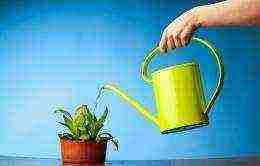
A flower watering can will help provide the plant with liquid.
- Watering can. The most common and safest way.Soft, weak jets of water do not wash out the soil, exposing the roots, and are safe for fragile green leaves. The wide nozzle allows the soil to be moistened evenly.
- Pallet. The method is called bottom irrigation and consists in the fact that water is poured directly into the pan, from where it is absorbed by the soil through the holes in the planter. The method is suitable for plants that love stagnation: monstera, cyperus, philodendron.
- Spray. It is not applied singly, but only in conjunction with one of the above. The aboveground part of the plants is sprayed with warm water. It is used with low humidity in rooms.
The water temperature should be at room temperature, fluctuations of no more than 5 ° C in both directions are permissible. Spraying is not useful for all plants; before irrigation, you should make sure with the help of reference literature that there is no harm from the process.
Back to the table of contents
Quality lighting for growing
Light is the main condition for the course of the process of photosynthesis, which is vital for indoor plants. Properly organized lighting helps them grow and develop. With a lack of it, the flowers become stunted, outwardly look inconspicuous.
Based on the type of plant and its location, you should decide what kind of artificial lighting will be: full or partial. If the plant is located near windows or on the balcony, then it will be enough to periodically illuminate it in the morning and evening, prolonging the daylight hours. If the flower pot stands in a dark place at home or does not receive sunlight at all, it will be necessary to select lamps that fully satisfy the conditions of detention.
Fix the luminaire so that it can be lifted as the flowers grow. You don't need to place it too high: the degree of illumination decreases with increasing height. The angle of incidence should not be sharp, the ideal solution would be light directed at the plants perpendicularly.
Back to the table of contents
Top dressing and fertilization
In nature, flowers are fertilized in the course of natural processes; growing plants at home requires human feeding. All fertilizers can be divided into the following groups:
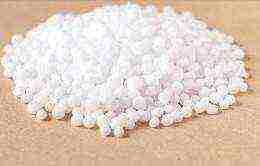
Mineral fertilizers in their composition may contain one or more elements, they are potash, phosphorus and nitrogen.
- Organic. They serve to improve the quality and structure of the soil, fill it with nutrients and microorganisms important for life. Provide oxygen access throughout the pot. Such fertilizers include humus, sawdust, manure, compost.
- Mineral. Varies depending on the number of components. Simple ones include those containing 1 element. In complex it occurs from two or more components. In terms of content, they are nitrogen, potash and phosphorus. Minerals nourish plants and provide them with rapid growth, but you cannot oversaturate the soil with them: this will negatively affect the soil and the plant.
- Bacterial. They increase the fertility of the soil and ensure high germination of seeds. They help the assimilation of nitrogen, convert it into a form convenient for plants.
- Microfertilizers and microelements. The preparations contain components that are missing for flowers (manganese, bromine, iron, zinc and others). They are introduced in small quantities and only according to indications for use.
Fertilizers are applied to the soil separately and on different days. The dosage is determined by the species and appearance of the flower.
Back to the table of contents
Green seed pet 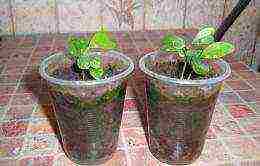
Growing a houseplant from seeds is not difficult, but it will take patience and proper care.
Growing indoor plants from seeds is not particularly difficult; patience and proper care are required. You can buy seeds at any flower shop. To begin with, it is better to opt for an unpretentious flower, for example, on abutilone, pelargonium, gloxinia.
The disadvantages of this method are that not all seeds germinate well and it may take several attempts to get viable seedlings. It will take a long time for the flower to grow and become decorative. The reason for the non-germination of seeds can be an expiration date or an incorrect temperature regime.
For sowing seeds, prepare the soil: lightly tamp and moisten it. Sow seeds and sprinkle them with a mixture of earth and sand. Cover with glass or plastic, periodically lifting them for ventilation and spraying. These are general rules, but you need to adhere to the planting method indicated on the seed bag.
Growing indoor plants is a great relaxation tool.
Many flowers have the ability to bring calm and serenity to the atmosphere of the home.
Many of them can purify the air from toxic substances and absorb electromagnetic radiation from household appliances. The subtle aromas of plants have a beneficial effect on people's emotional health and decontaminate premises. Observing the rules of caring for plants, you can create your own corner of nature. Self-grown plants will bring moral satisfaction and unity with the green oasis of your home.
Similar articles:
 Unpretentious indoor flowers blooming all year round - the dream of any floristwho grows indoor plants at home. Beautiful flowers will cheer up anyone. But such flowers are not only a beautiful addition to the interior. Flowers at home are also a great practical benefit. Don't forget that growing flowers at home is an exciting hobby.
Unpretentious indoor flowers blooming all year round - the dream of any floristwho grows indoor plants at home. Beautiful flowers will cheer up anyone. But such flowers are not only a beautiful addition to the interior. Flowers at home are also a great practical benefit. Don't forget that growing flowers at home is an exciting hobby.
The main thing is that the flowers are not only beautiful, but also unpretentious, because not every gardener can take care of capricious, demanding care. Even the most beautiful flowers should not be planted at home if caring for a plant takes a lot of time and effort, and an amateur florist, in addition to growing flowers, also works. The modern pace of life dictates its own rules: for growing at home, it is best to choose flowers that are not only beautiful, but also unpretentious.
Blooming indoor plants: practical benefits
Unpretentious indoor flowersblooming every year at home are of great benefit. These flowers are ideal for interior decoration:
- In a private house or city apartment;
- At the dacha, where the owners are periodic "visits";
- In kindergarten or school;
- In a hospital or clinic;
- In the office.
They are of great benefit. They saturate the air in the room with oxygen, while absorbing carbon dioxide. The flowers that appear on them create a cozy atmosphere and encourage communication in a calm atmosphere. Plants blooming all year round - ideal for a "restroom" in a factory, office or train station. They are frequent "guests" in greenhouses and conservatories. In addition, some of the indoor plants that bloom all year round have medicinal properties. Some of them can be eaten.
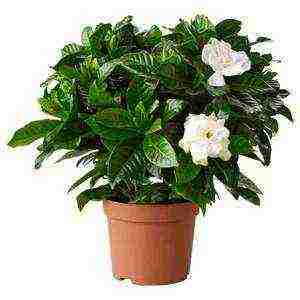 For example, fragrant tea can be made from jasmine leaves, and gourmets can make jam from rose petals. However, before carrying out medical or culinary experiments with indoor plants, you need to carefully examine it for pests or parasites. If, as a result of the inspection, traces of the vital activity of harmful insects are found, it is not recommended to eat the leaves (stems) or use the leaves (stems) for medicinal purposes.
For example, fragrant tea can be made from jasmine leaves, and gourmets can make jam from rose petals. However, before carrying out medical or culinary experiments with indoor plants, you need to carefully examine it for pests or parasites. If, as a result of the inspection, traces of the vital activity of harmful insects are found, it is not recommended to eat the leaves (stems) or use the leaves (stems) for medicinal purposes.
Most often, indoor flower lovers grow fuchsia, indoor jasmine, indoor rose, as well as zygocactus, or Decembrist at home.... Despite its name, it doesn't bloom only in December. With proper care, zygocactus can bloom all year round.He just does not like heat and blooms more actively when the temperature in the room is not the highest.
Also, many growers who do not like to pay much attention to their plants willingly grow succulents at home, for example, cacti and agave. The only disadvantage of such flowers is that you can expect flowers from them once every few years. However, they look original even without flowers, therefore they are very popular when decorating the interior of non-residential premises.
Indoor plants that bloom all year round: proper care at home
Unpretentious indoor flowers blooming every year at home, require proper care... The fact that they are called unpretentious does not mean that they do not need care. Care is needed, however, it takes very little time and energy. This is their main advantage. Indoor plants, blooming all year round and undemanding to care, quickly adapt to any climatic conditions and temperature changes.
If an amateur florist is forced to leave the house for several days, they will calmly live those few days without watering or with an automatic watering system. They also do not require frequent feeding, because they are undemanding to the chemical composition and level of soil acidity. List of activities for the care of indoor plantsblooming all year round includes the following activities:
 Watering;
Watering;- Loosening the soil;
- Pest and parasite control;
- Ensuring the correct functioning of the drainage system;
- Transplant, as they grow, into larger pots.
Plants that are undemanding to care for and bloom all year round require regular watering because they expend a lot of energy to bloom year round. In this case, the liquid in the pot should not be allowed to stagnate, so the soil must be loosened regularly. Loosening is a kind of ventilation that allows the soil to "breathe". If you neglect loosening and keep flowers in pots that are not equipped with drainage holes, the liquid will stagnate, and this, ultimately, will lead to serious fungal diseases and gradual decay of the root system.
Unpretentious plants that bloom all year round, periodically need feeding, but with feeding it is better not to overdo it. These flowers adapt well to any soil composition. In summer, they feel good on the balcony, on the terrace or veranda of the summer cottage. However, you should not keep them in the fresh air until frost, because they are still houseplants, accustomed to certain climatic conditions. It is necessary to accustom them to fresh air gradually, starting from a few minutes. If you take out a plant that is not used to fresh air on the balcony for the whole day, it will not have time to adapt to the new conditions. In autumn and winter, it is better not to "walk" indoor sissies.
Houseplants that bloom all year round: pest and parasite control
Unpretentious indoor flowers blooming every year at home will look beautiful only if the flowering plants are not affected by pests and parasites.
It is much easier to prevent the invasion of parasites and pests than, by losing time, then treating a diseased flower. You need to regularly inspect the flower the presence of pests and parasites is indicated by the following signs:
 Suddenly and quickly yellowed leaves;
Suddenly and quickly yellowed leaves;- Leaves that curl themselves into a tube;
- Deformed flowers of irregular shape, drying quickly;
- A large number of dried and unblown buds;
- Sticky or damp marks on leaves and stem. Chances are, the leaves and stem have become sticky from the mucus produced by the pests.
In order for the pests to disappear, it is necessary to regularly spray the plants with a spray bottleremoving dust and dirt from the leaves. To destroy pests, you need to spray the flower with insecticide solutions.Leaves, stems and flowers affected by parasites must be cut and burned in time. Plants most severely affected by dangerous pests are transplanted into another pot and isolated from their "neighbors" until the harmful insects disappear completely. Plants blooming all year round are a tidbit for spider mites. The spider mite is very fond of dust, therefore, in no case should dust appear on the leaves.
Houseplants blooming all year round: precautions
It must be borne in mind that many indoor flowers, loved by flower growers for their undemanding care, can provoke allergic reactions in children and adults suffering from bronchial asthma and prone to allergies. Also, among the unpretentious indoor plants, there are many poisonous. A typical example of such a flower is indoor ivy, which has flowers with an unpleasant smell and deadly poisonous berries.
Before bringing home a new houseplant, an amateur florist should definitely read the details of the new flower in a floriculture guide. It is not recommended to keep at homewhere there are children and pets, houseplants that:
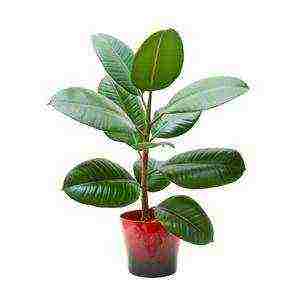 Are strong allergens;
Are strong allergens;- Have a pungent or unpleasant odor;
- Allocate acrid juice;
- They have poisonous fruits.
It is best to keep such plants in non-residential premises, with the exception of children's institutions. Plants that have a pungent or offensive odor are best kept in spacious and well-ventilated areas, such as assembly halls or conference rooms, because the pungent odor is not so strong in a large room.
Indoor plants that bloom all year round: practical recommendations
Those who want to grow indoor plants that bloom all year round should keep in mind that these flowers need a lot of energy to bloom all year round. If you neglect watering and other care measures, the flower will not live long. However, with proper care, on the contrary, it will actively grow, develop and please the eye.
Before choosing a year-round flowering houseplant for an apartment or a private house, you need to weigh the pros and cons, and also find out the most detailed information about this plant. The main thing is that it is not poisonous and does not cause allergies. It is best to purchase indoor plants that bloom all year round in specialized stores.
 It is not recommended to buy indoor "plants" in the marketsbecause they can be infested with pests or parasites, or infected with fungal infections. You need to choose plants that look healthy, have no visible defects and damage. Young plants take root best at home. The younger the indoor flower, the faster it adapts to the new environment. If the hobby gardener is often away from home for several days, an automatic watering system based on capillary mats can be purchased with the plants.
It is not recommended to buy indoor "plants" in the marketsbecause they can be infested with pests or parasites, or infected with fungal infections. You need to choose plants that look healthy, have no visible defects and damage. Young plants take root best at home. The younger the indoor flower, the faster it adapts to the new environment. If the hobby gardener is often away from home for several days, an automatic watering system based on capillary mats can be purchased with the plants.
Indoor plants that delight with their flowers all year round are a great opportunity to decorate the interior of a residential or non-residential premises. The main thing is that they fit the interior and do not harm those who live in the room. Unpretentious indoor flowers that bloom all year round are ideal for a novice indoor florist who is taking the first steps in growing their own flowers. They are also loved by experienced specialists in indoor plants, for their beauty, simplicity and benefit.
>
1 Growing indoor flowers - secrets
In order to carry out all the work on our own, we need the following:
- Priming
- Capacity (pots)
- Seeds of selected plants
- Top dressing or mineral fertilizers
Today we will only considerseveral planting options for the most famous flowers among the gardeners who grow them on their windowsill.
- Geranium is one of the most preferred plants for those who decide to create their own cute garden at home. The best time to sow is December or January. In this case, you should get ready - the first shoots may appear in about a month. The soil for this species should be soft and loose, you can also add a little sand. To increase seed germination, mix the soil with humus. The container should be small with a special drainage hole. Sowing seeds is done on top, at the end, sprinkle the future geranium with earth. The pot should be covered with either plastic wrap or a glass jar. Do not forget that this variety loves light, and therefore you should choose sunny places for the pot. After the shoots appear, remove the film. Watering should be done sparingly, and when the first leaves appear, be sure to transplant the flower into a separate pot.
- Streptocarpus is very popular and is an excellent plant for planting at home. If you provide it with good lighting, this flower will delight you with its brightness throughout the year. It is necessary to start work in the spring. The pot must have a hole for the liquid to drain. The best soil for streptocarpus is a mixture of agroperlite, vermiculite and peat. Sprinkle the seeds of the plant evenly in a pot and sprinkle a little with earth. The location for the pot should be warm and light. After planting, cover the container with foil and water it from time to time. After the sprouts appear, the plants are transplanted into a deeper pot.
- Gloxinia is considered one of the easiest plants to plant at home. The soil should contain a large percentage of peat, in addition, fertilizers can be added. Even a small plastic cup is suitable as a container for disembarkation, and do not forget to cover it with foil. This will allow you to create the necessary conditions for the normal development of gloxinia.
In the photo - a houseplant geranium,
In the photo - a houseplant geranium,
In the photo - indoor flower streptocarpus,
In the photo - indoor flower streptocarpus,
In the photo - indoor flower gloxinia,
In the photo - indoor flower gloxinia,
Photo of the names of indoor flowers,
Photo of the names of indoor flowers,
In the photo - indoor flower,
In the photo - indoor flower,
2 Indoor flowers - care and cultivation
Growing indoor flowers from seeds, first of all, should interest you. As you know, they love human attention. That is why you need to sometimes "communicate" with them, understanding and meeting their needs. It must be remembered that care is not only about watering, but also about taking care of flowers. When choosing certain varieties of plants for their subsequent planting in an apartment, be sure to clarify the conditions for their cultivation and subsequent care.
This includes the requirements for soil, lighting, watering. This will be the key to their health. Don't forget about pests that can kill flowers. That is why you should buy "medicines for green friends", they are also selected individually. If the flower does get sick, be sure to wipe the visible roots and leaves with a clean, damp cloth, and do not forget to feed them, which will make your flowers more resistant to diseases. When choosing a soil, remember that it must pass liquid without trapping oxygen.
Pay attention to the pots - as you grow, be sure to change the containers to the size of the plants. And if you follow all the advice, treat the grown flowers with love, they will delight you with their freshness, bloom and beauty.
In the photo - a blooming indoor flower,
In the photo - a blooming indoor flower,
Photo of a room with colors,
Photo of a room with colors,
In the photo - growing indoor flowers,
In the photo - growing indoor flowers,
In the photo - the sale of indoor flowers,
In the photo - the sale of indoor flowers,
Photo of indoor flowers,
Photo of indoor flowers,
3 Growing indoor flowers - tips from gardeners
A lot depends not only on the correct cultivation, but also on the choice of the location of the flower pot. It is thanks to this that they will not only be healthy, but will also be able to make your apartment much more beautiful and more comfortable. Landscaping of a plot or apartment is a real art, it requires understanding and knowledge of the qualities of plants. First of all, you need to consider the size of your apartment and the level of illumination. It is rather difficult to recommend certain varieties of flowers, since their range includes several hundred species.
The main thing is to choose them so that they either bloom 365 days a year, or replace each other. That is why so many people prefer evergreen perennial plants that can delight you endlessly with proper care. If you want to create any composition, you must first of all define the task that you set for yourself while using them in the room.
- Disguising ugly places
- Visual connection with nature
- Emphasis on any interior elements (doorways, windows, bay window)
If you are planting plants in shaded areas, choose ones that stand out for their bold silhouette, leaf ornaments, or lush crown. These flowers include monstera, hamedoria, anthurium and some varieties of palm trees. Vines or other climbing plants that are suspended in a planter do not so much interfere with the penetration of sunlight into the apartment. Choose them according to their height, since a tall palm tree will not look in an apartment with low ceilings. Do not forget that you need to arrange them so that they are simultaneously in their natural position and at the same time do not take up much space. Growing flowers is a pleasant work that will bring you a lot of positive emotions.
